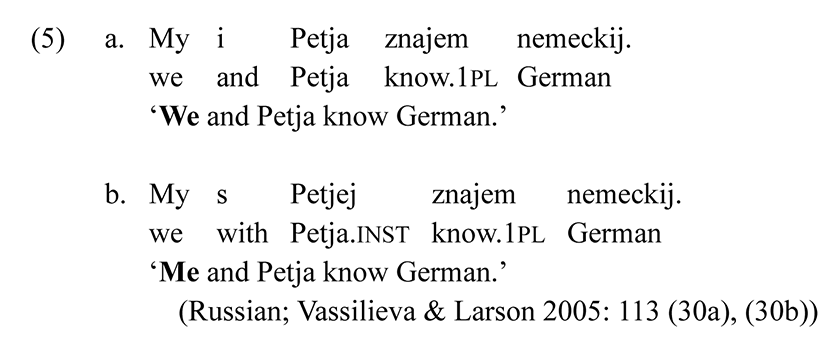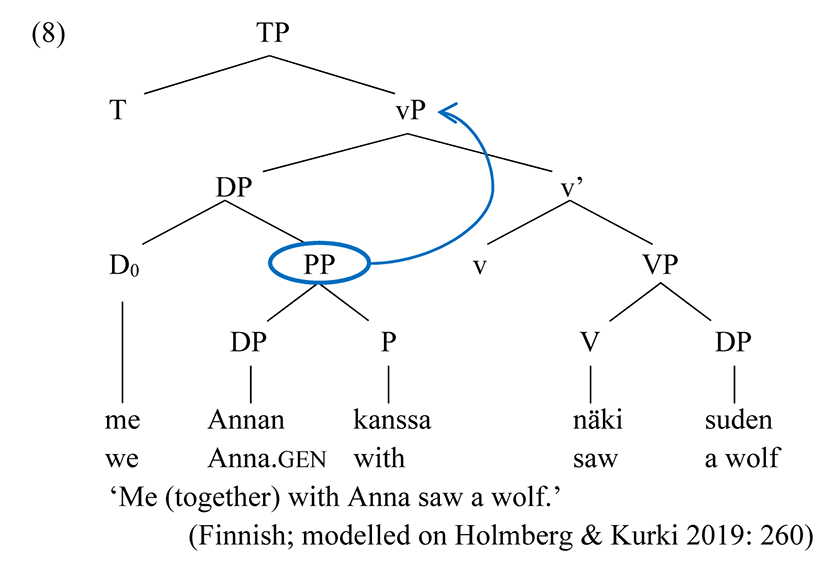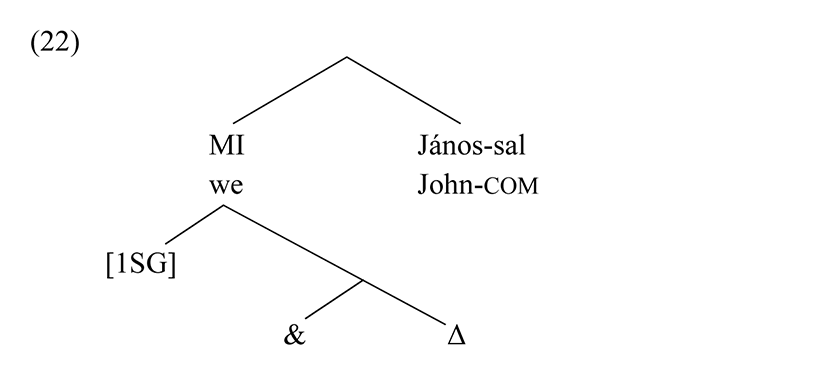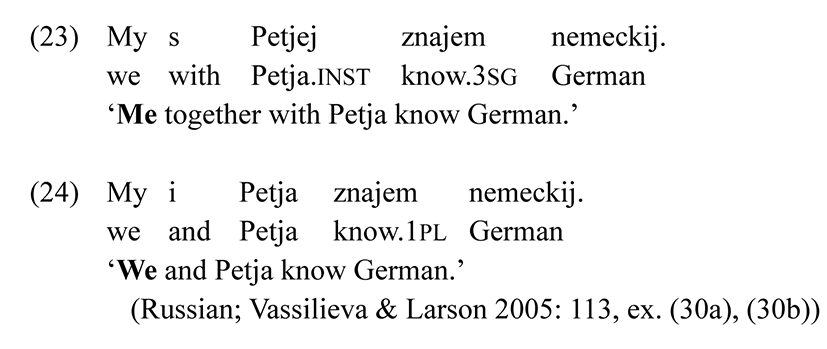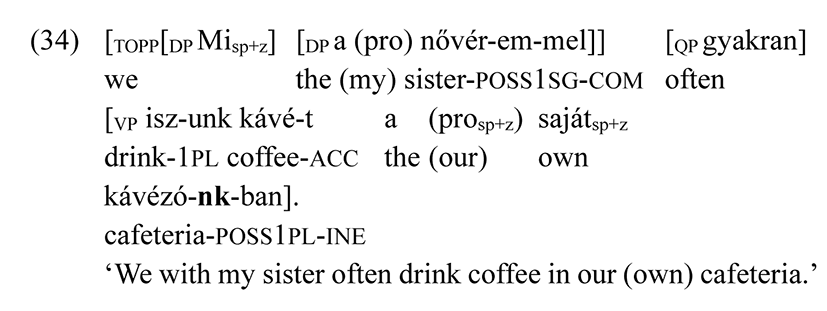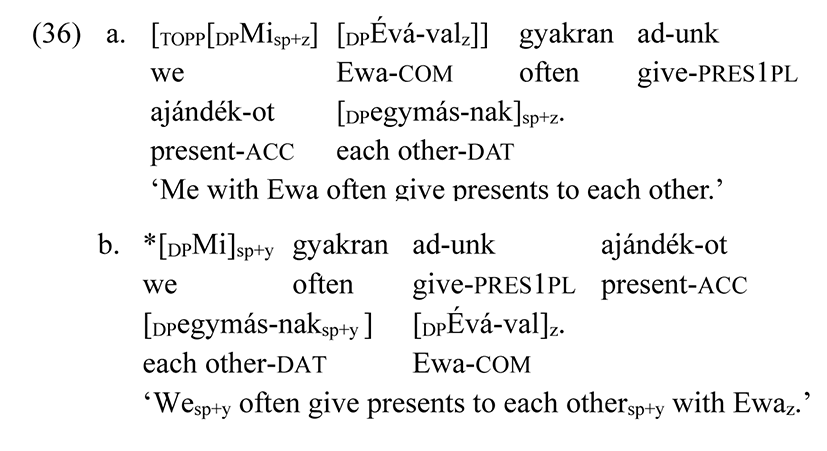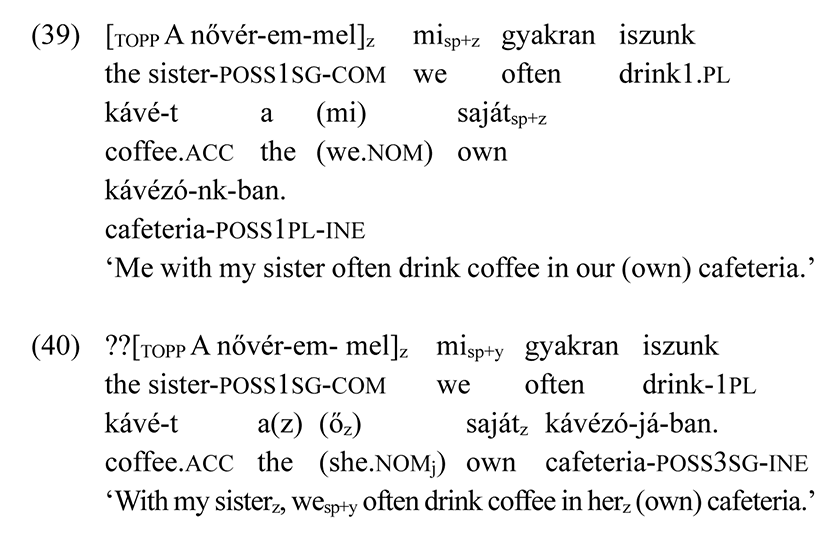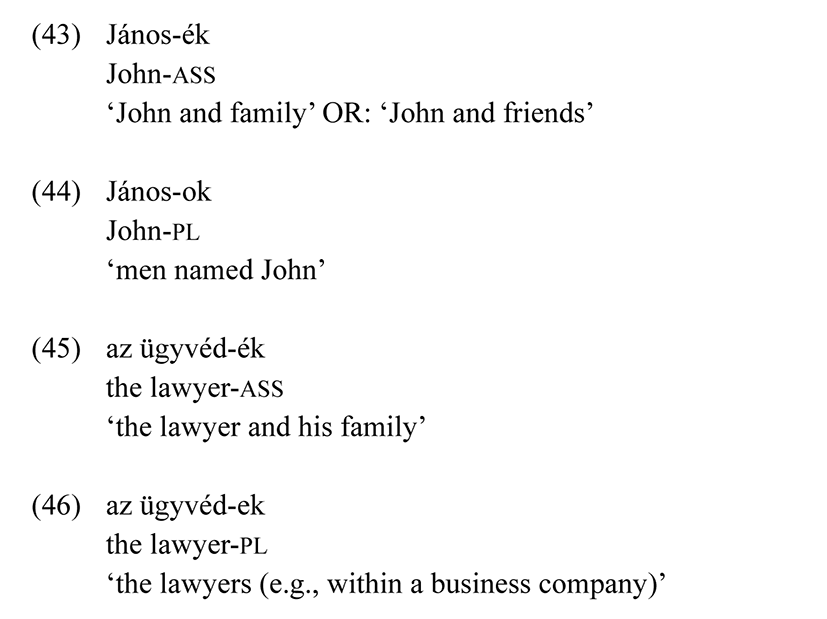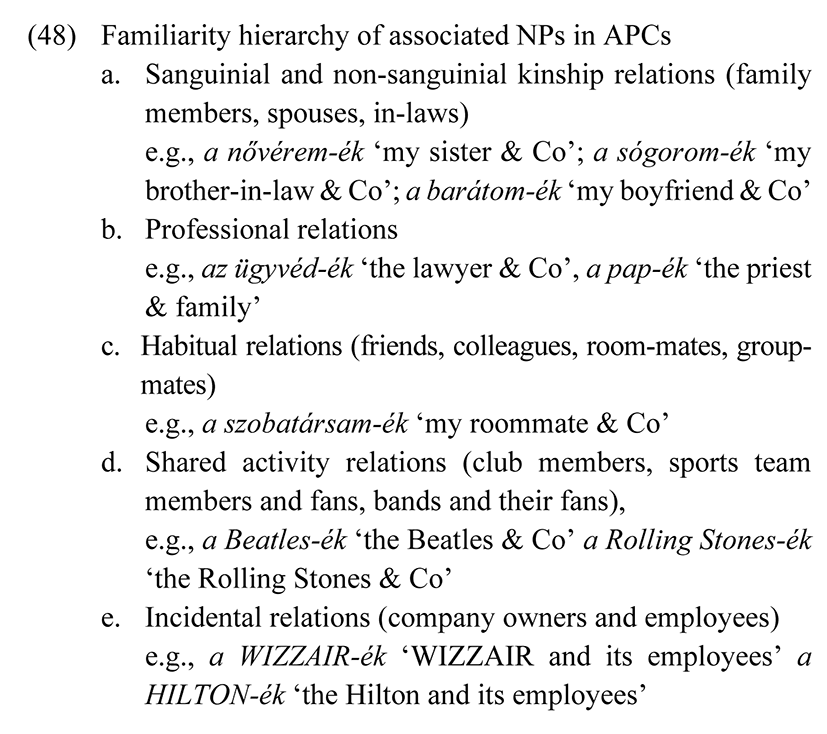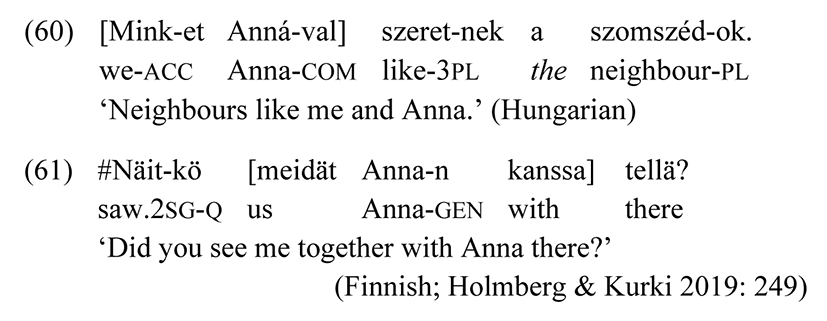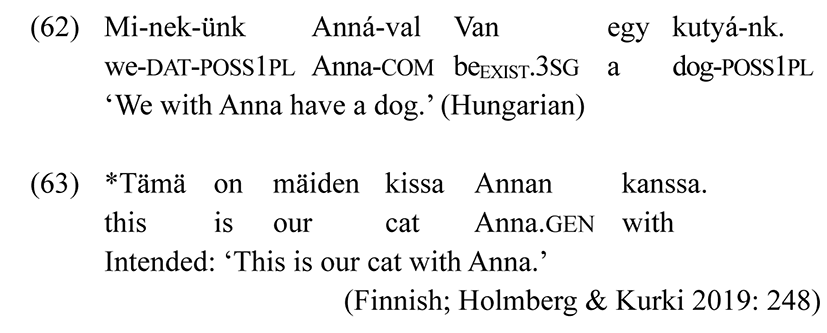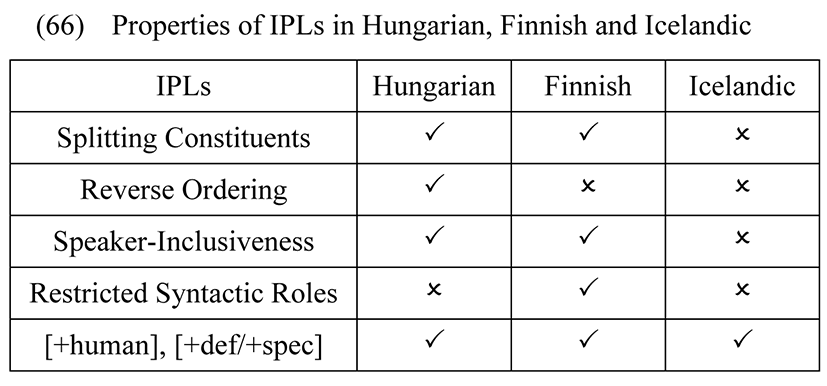1. Introduction
The first person plural personal pronoun WE can be interpreted either as inclusive or as exclusive in several languages (see Simon 2005, Cysouw 2008). Under the inclusive interpretation, the speaker and the addressee constitute the reference set. Under the exclusive interpretation, the addressee is excluded, only the speaker and some non-speech-act participants are involved, see Figure 1.1

Inclusory plural pronominal constructions (henceforth: IPPCs2) are peculiar in that the 1PL pronoun is accompanied by a comitative nominal phrase and the referent of the comitative phrase is included in the reference set of the plural pronominal head. It is possible, however, to interpret the comitative nominal phrase as a VP-modifying adjunct, in which case its referent is not included in the reference set of WE:
While English follows pattern (b), with the comitative DP excluded from the reference set of WE, in languages like Tlingit, Russian and Polish, pattern (a) is the natural interpretation, in which WE includes only the speaker and the referent of the comitative DP but nobody else (see Cable 2017 for details).
The aim of this paper is twofold: (a) it addresses the question of to what extent Hungarian IPPCs resemble or differ from their recently studied counterparts in Finnish, Icelandic and Russian; (b) it also investigates whether the existing analyses provide an appropriate account for the syntactic and lexical-semantic properties of Hungarian IPPCs. The reason for selecting the above languages lies in the comparative nature of the paper. The recent accounts of the corresponding constructions in these languages do not give a satisfactory account of the facts of Hungarian. The paper proposes an alternative account of inclusive and exclusive personal pronouns, as well as of IPPCs, which is based on feature composition (see Bianchi 2006).
The paper is structured as follows. After presenting IPPCs and their interpretation in general, section 1 introduces such constructions in Finnish, Icelandic and Hungarian. In section 2, current accounts of these constructions in Finnish and Icelandic are briefly discussed, highlighting some specific features of IPPCs in these two languages. In 3.1 the existing analyses of IPPCs in Russian and Hungarian are surveyed, and some of their advantages and disadvantages are pointed out. In 3.2 an alternative syntactic analysis of Hungarian IPPCs as DP-internal complements3 is proposed. In section 4, Hungarian IPPCs are compared with APCs. Section 5 surveys the properties of Hungarian IPPCs which distinguish it from Finnish and Icelandic IPPCs. Part 6 is a summary.
Vassilieva and Larson (2005) propose that plural personal pronouns carry two indices, which define their reference set. In their theory, the traditional division of 1PL personal pronouns into inclusive and exclusive is expressed indexically. Notice, however, that IPPCs in this system are neither inclusive nor exclusive.4
Such constructions have recently been investigated by Holmberg and Kurki (2019) in Finnish; by Sigurðsson and Wood (2020) in Icelandic; and by Moravcsik (2003) and Dékány (2009) in Hungarian. What relates these three languages is that, unlike in English, only the reading in which the reference set of the plural pronoun includes the speaker and the referent of the comitative PP/DP/NP is available for them.5
Starting with Finnish, Holmberg and Kurki (2019) (henceforth H & K) list the characteristic properties of IPPCs as follows:
-
(i) The referent of the comitative PP is [+human] (typically kin or close associate; see Holmberg & Kurki 2019: 257, section 5).
-
(ii) The nominal head within the comitative PP is definite and/or specific (see Holmberg & Kurki 2019: 258 (35c)).6
-
(iii) The pronominal head is [+animate], [+human], and most often 1PL.7,8
-
(iv) The IPPC has restricted syntactic functions. It can function as subject or topic, however it is excluded from the possessor or direct object functions (see Holmberg & Kurki 2019: 248).
-
(v) The pronominal head and the comitative PP may form a discontinuous syntactic unit, i.e., these constituents can be split from each other, though their linear ordering cannot be reversed (see Holmberg & Kurki 2019: 247).
Finnish IPPCs, as described by Holmberg and Kurki (2019), are typically built on the 1PL pronoun WE plus a comitative PP:
Despite the 1PL pronominal head, the meaning of such constructions in Finnish is not “WE together with x”; rather, they are interpreted as “ME together with x and nobody else”.9
In the corresponding Icelandic Pro[NP] construction there is no overt morphological indication of the syntactic relationship between the pronominal head and the associated DP (“the annex” in the terminology of Sigurðsson & Wood 2020) that follows it:
The Finnish example in (2) can be expressed in two ways in Hungarian: either by mere coordination, or by a pronominal construction with a COM-marked DP in it. In the first case, the pronominal member of the coordination is 1SG, and is connected to the associated DP by the conjunction and. In the second case, the pronominal head is 1PL and is followed by the COM-marked DP:
As Vassilieva and Larson (2005) point out for Russian and Polish, IPPCs cannot be analyzed as conjoined structures because the truth conditions of conjoined DPs differ from those of IPPCs. In the case of conjoined DPs, the reference set of the pronominal head includes the speaker and some others, while in the latter, it includes only the speaker and the referent of the comitative DP. This excludes any analysis of true IPPCs based on conjunction.
Notice that in (5a) the reference set of the 1PL personal pronoun we does not include Petja. In (5b), by contrast, the speaker and Petja are the only referents included in the reference set of the 1PL personal pronoun in the given discourse universe.
It must be noted here that Hungarian IPPCs differ morpho-syntactically and semantically from APCs to a great extent (the latter is formed by the help of the associative suffix -ék, see Moravcsik 2003, Daniel 2005, Daniel & Moravcsik 2008).10 Nonetheless, these two constructions are often mentioned together, as they impose similar lexical-semantic restrictions on their reference set (see Corbett 2000: 201–211):
In both constructions, the associated group is normally [+human], [+definite] and/or [+specific], and must be in close sociological relation (kin or associate) with the referent(s) of the pronominal head or the lexical head (see M. Korchmáros 1995, Moravcsik 2003, Daniel & Moravcsik 2008). Both constructions are group-denoting expressions, though they differ with respect to clusivity. While the pronominal head of IPPCs is typically speaker-inclusive 1PL, the APC is speaker-exclusive, and its referent can only be 3PL. I will return to this issue in section 4 of this paper.11
2. Current Analyses of IPPCs in Finnish and Icelandic
One problem these constructions immediately raise is how the 1PL personal pronoun receives the inclusory interpretation, i.e., how it can refer to the speaker plus the referent of the comitative DP only. Holmberg and Kurki (2019) adopt Vassilieva and Larson’s (2005) account, who claim that the 1PL pronoun WE comprises two sets of variables {X, Y}. The first set is a singleton, including only the speaker, which has the 1SG feature; the second set is contextually determined. Based on Holmberg and Kurki’s (2019: 261) proposal, a simplified X-bar theoretic structure of the Finnish construction is given in (7).12 The D0 head inherits the feature bundle of both sets, and serves as a c-commander for the comitative PP.
Holmberg and Kurki (2019) derive the relatively flexible placement of the constituents of IPPCs in the sentence via remnant movement, whereby the comitative PP is left-adjoined to vP and the remnant DP moves to the left (Holmberg & Kurki 2019: 261).
Once we accept that IPPCs do not necessarily enter the canonical [Spec, TP] subject position (see Holmberg 2000, Holmberg & Nikanne 2002 and subsequent work), we can assume that they move to some left-peripheral position reserved for discourse-semantic functions straightaway, while the verb performs head movement to T0. Alternatively, the pronoun can move to the left periphery on its own, leaving the rest of the DP behind. This will make remnant movement unnecessary.13
The analysis proposed by Holmberg and Kurki (2019) cannot be directly applied to the corresponding Icelandic Pro[NP] construction (see Sigurðsson & Wood 2020), where the pronominal head and the associated DP (“the annex” in their terminology) never split but show case agreement. Sigurðsson and Wood (2020) derive the Icelandic plural pronominal construction by assuming a silent functional head, which they call LOCK and signal it as ⁍. The LOCK head ensures that the pronoun and the annex are rigidly kept together:14
Similar constructions in Finnish or Russian are also claimed to have a silent LOCK head in their analysis. The authors claim that an overt connector like the Finnish postposition kannsa ‘with’, or the Russian preposition . ‘with’ (or, we could add, the Hungarian comitative suffix -val/-vel ‘with’) may break the LOCK, and in such cases the pronoun and the annex can split.
Icelandic plural pronominal constructions are not restricted to first person, they are commonly formed in all persons of the plural. This is in sharp contrast with Finnish IPPCs, in which the 1PL is the most common type: “Our impression is that the most common instantiation … is with we [but it can be you.PL and marginally they]” (Holmberg & Kurki 2019: 253; see also fn. 3). Furthermore, the inclusory reading of the comitative DP is not necessarily implied in Icelandic:
As is noted by the authors, the members of the two reference sets, he and Olaf, can be strong independently, hence the “together” interpretation is possible but not compulsory.
Due to the absence of any overt morphological reflex of their internal syntactic relations, the only way to ensure the inclusory plural interpretation is to block the pronoun and the annex from splitting or from reverse linear ordering via LOCK:15
At first glance these plural pronominal constructions may seem strikingly similar to appositive constructions, such as ‘we, linguists’. As is explicated by the authors, appositive constructions have nothing in common with IPPCs for the following reasons:
Icelandic appositive constructions16
In contradistinction to IPPCs, in which the comitative DP is the complement of the pronominal head, appositive DPs are taken to be adjuncts cross-linguistically because they postmodify the whole DP, not just the head:
Icelandic Pro[NP] constructions also differ from APCs (obsolete in present-day Icelandic, see Sigurðsson & Wood 2020) in that the latter, if they existed today at all, ought to be interpreted as 3PL, and the whole construction would read as ‘Pro and associates’:
There is no person/number agreement between the focal member and the associated DP in APCs in general. The focal member is normally a proper name or a profession name, and the associated group is left unspecified. As the authors note, the example in (16) could hardly have the associative plural reading in present-day Icelandic. Constructions of this kind, however, can have the preproprial reading: Hann, Ólafur ‘Olaf, you know who I mean’ (see the discussion in Sigurðsson & Wood 2020: 10–11).
After surveying similar constructions in Finnish and Icelandic, let us now turn to Hungarian IPPCs.
3. The Hungarian Scenario
As Vassilieva and Larson (2005: 102) point out, the comitative phrase in Russian can appear at various levels of the clause structure: it can function (a) as a DP-internal complement; (b) as a DP-internal adjunct, or (c) as a VP-modifying adjunct. The structure of Russian IPPCs in Vassilieva and Larson’s analysis roughly corresponds to its Finnish counterpart given in (7), in which the comitative phrase is the complement of the D0 pronominal head within the DP (see Vassilieva & Larson 2005: 114, Part 4). For the present purposes, only the DP-internal complement vs. the VP-modifying adjunct roles of the comitative phrase are relevant.17 Other uses of the comitative phrase will not be discussed here, as they are not directly relevant for Hungarian.18
The two occurrences of the comitative PP in (17a), (17b) correspond to two different readings. In (17a), the comitative PP is a DP-internal complement of the pronominal D0 head. This gives rise to the inclusory interpretation of the subject DP, under which the referent of the comitative PP is included in the reference set of the 1PL pronoun. In (17b), by contrast, the referent in the comitative PP is outside the interpretive domain of the 1PL pronominal subject. Here the comitative PP is simply a VP-modifying adjunct. Thus, the syntactic positioning of the comitative phrase is a diagnostic feature of clausal constituency in Russian.
The authors support their analysis of IPPCs by the binding properties of the reflexive possessive pronoun svoj ‘own’ in Russian.
Anaphoric binding of svoj ‘own’
Notice that in (18), the comitative phrase is the complement of the pronominal head, and the reflexive possessive pronoun svoj ‘own’ takes the whole DP as its antecedent. This is not so in (19), where the referent of the comitative phrase is not included in the reference set of the 1PL personal pronoun we. Svoj in this case can construe with the 1PL personal pronoun my ‘we’ and the comitative phrase s koskoj ‘with cat’ independently, yielding the non-inclusive reading.19
Vassilieva and Larson (2005) derive the semantic interpretation of plural personal pronouns from their singular counterparts in such a way that they introduce a contextually determined Δ [delta] variable:
If we wanted to follow this track, we would have to assume that the Δ variable is also present in the case of IPPCs, whose value would then be contextually determined. This, however, cannot be maintained, given that the value of the Δ variable is determined by the lexical content of the comitative PP, which does not change according to the context. Notice, nevertheless, that the authors’ concept implicitly forces viewing the comitative PP under the inclusory interpretation as a DP-internal complement, and not as a VP-modifying adjunct. This does not leave any room for ambiguity.20
Though this approach has a certain degree of theoretical appeal, it does not justify the introduction of a contextually determined Δ variable in the case of inclusive/exclusive WE and in the case of IPPCs. As we have already seen, inclusive WE has the speaker and the addressee in its reference set, whilst IPPCs have the speaker and the referent of the comitative phrase in their reference set. Exclusive WE has the speaker and some others (not participating in the discourse) in its reference set. This eliminates the need for any contextually determined variable.
In pragmatically inclined syntactic analyses, 1st and 2nd person pronouns are characterized as speech act participants, and are equipped with the [+SAP] feature (see Bianchi 2006). This distinguishes them from 3rd person pronouns, whose referents are not speech act participants, and are therefore assigned the [–SAP] feature. The reference sets of inclusive vs. exclusive WE, as well as the IPPC can, accordingly, be defined as follows:
Given that Z is specified as [–SAP], and there is no other nominal present in the construction, it is the only entity that can be identified as the referent of the comitative phrase in the given discourse universe, yielding the inclusory reading. This makes the introduction of the Δ variable unnecessary. Another significant advantage of introducing the [±SAP] feature, to be discussed briefly in the next subsection, is that IPPCs can be segregated from conjoined DPs.
In her analysis of IPPCs, Dékány (2009: 239) proposes that the comitative DP is incorporated into the plural pronominal head:
In this structure, the Δ variable set is conjoined with the 1SG pronoun and its value is determined by the comitative DP, which is incorporated into the plural pronominal head.
Though the main objective of this paper is not to give a critical overview of Dékány’s analysis, it seems important to point out some problems raised by it, as it is widely accepted in mainstream Hungarian syntactic theorizing.
Her analysis cannot be maintained for the following reasons. First, it is unclear what the role of the Δ variable is and why the 1SG pronoun should be conjoined with it. As Vassilieva and Larson (2005: 121) point out, conjoined structures differ from IPPCs in their truth conditions. As a consequence, the conjoined structure in (24) can only have the non-inclusory reading, whereas the IPPC in (23) must be interpreted as inclusory. Thus, (23) implies that the speaker and Petja know German as a group, while in (24) this interpretation is absent:
The same is true for Hungarian. While the conjoined structure in (25a) has the non-inclusory reading, the IPPC in (25b) can only have the inclusory interpretation.
Second, the tests Dékány (2009) adopts from Vassilieva and Larson (2005) (wh-extraction, restrictive relative clauses, paraphrases, etc.) are meant to tell apart comitative phrases interpreted either as included or as not included in the reference set of WE in Hungarian. Nonetheless, in her account, the comitative DP is taken to be DP-internal both under the inclusory and under the non-inclusory interpretations. Her tests may be helpful for segregating DP-internal complements from DP-internal adjuncts in general but not from VP-modifying adjuncts. These tests are not informative for the DP-internal complement versus VP-modifying adjunct status of the comitative phrase, which is taken to be equivalent to the inclusory vs. non-inclusory interpretations here, respectively. What Dékány calls DP-adjunction is, in fact, a DP-internal complement:
“I take these data to point to the conclusion that the pronoun and the comitative form a constituent, and thus corroborate the DP-adjunction analysis.” (Dékány 2009: 238).
The pronominal head and the comitative phrase can only form a syntactic unit if the comitative DP is the complement of the pronominal head. Indeed, this is exactly the scenario in which the referent of the comitative DP is included in the reference set of the 1PL pronoun, giving rise to the inclusory interpretation.
Under the other interpretation, which she calls exclusive, the comitative phrase is referred to as an appositive modifier. If such appositive modifiers existed in Hungarian at all, they would certainly have to be also DP-internal. Unfortunately, Hungarian comitative DPs do not function as DP-internal appositive adjuncts, therefore the problem can be reduced to the DP-internal complement vs. VP-adjunct dichotomy.
Hungarian IPPCs are formed by the help of the 1PL pronominal head and a comitative case-marked DP. In this section first the lexical-semantic properties, and after that the syntactic properties of these constructions will be looked at.
Just like in Finnish, the comitative DP in Hungarian must be a [+human], [+definite] and/or [+specific] NP, whose referent must be in close sociological relationship with the speaker:
Indefinite or inanimate NPs cannot function as comitative DPs in IPPCs as they do not meet these requirements:21
Pronouns cannot appear as comitative DPs in IPPCs, irrespective of their [±DEF] feature:22
Though at this point we cannot provide an explanation as to why pronouns do not qualify as comitative DPs in IPPCs, it is worth noting that pronouns are also ruled out as potential focal heads in APCs (see Moravcsik 2003).
The syntactic structure of Hungarian IPPCs resembles the corresponding Finnish construction, except that in Hungarian the comitative reading is introduced by the -val/-vel ‘together with’ case marking.23 The comitative DP is the complement of the pronominal head, yet, there is no strict adjacency requirement for it; they can be freely split (28). What is more, not even their linear ordering is fixed, as is shown in (29):24
In (28) and (29), the comitative reading25 of the DP-internal complement is due to its [+human] feature. If we replace it by a [–human], [–animate] DP, the same case-marking gives rise to the instrument reading:
In such cases, only the VP-modifying adjunct interpretation is available, the inclusory reading does not even arise. Incidentally, the comitative DP and the instrument DP can also appear simultaneously, both as VP-modifying adjuncts. The fact that their relative ordering is fixed indicates that even in such cases, the two adjunct DPs do not have identical syntactic status. This is probably due to the so-called Animacy Hierarchy (see Corbett 2000).26
Personal pronouns in Hungarian are taken here to be fully referential DPs in all persons (see Dalmi 1998, 2002). They are defective only in the sense that they do not readily lend themselves to pre- or postmodification. This alone, however, is not sufficient for assigning different structures or different levels of complexity to them (but see Bartos 1999 for the opposite view).
Referentiality is a property of nominals, not of determiners. In particular, it is the N0 head that bears the [±D] feature,27 which must be licensed in D0 (cf. Abney 1987).28 This triggers the N0-to-D0 movement of the pronominal head, in the sense of Longobardi (1994). For this reason, I take Hungarian personal pronouns in all persons to be full, referential DPs.
As was noted above, the inclusory interpretation emerges only if the comitative DP appears as the complement of the pronominal head; in all the other cases discussed here, the comitative DP functions as a VP-modifying adjunct, with the non-inclusory reading. The two readings can be isolated by adding the reflexive possessive pronoun saját ‘own’.29
The reflexive possessive pronoun saját ‘one’s own’ construes with the thematically most prominent antecedent in its minimal domain.30
In (34), the whole subject DP mi a nővéremmel ‘me with my sister’ is interpreted as the owner of the cafeteria, which is shown by the 1PL possessive suffix on the possessee. In this capacity, the subject DP serves as the antecedent for the reflexive possessive pronoun saját ‘one’s own’ (for a detailed analysis of reflexive possessive pronouns in Hungarian, see Rákosi 2014):
In (35), by contrast, where only the head of the comitative DP a nővérem-mel ‘my sister-COM’ is understood as the sole owner of the cafeteria, the reflexive possessive pronoun saját ‘own’ is interpreted as coreferential with that owner alone. This is again shown by the 3SG possessive suffix on the possessee. The non-inclusory interpretation becomes possible because the comitative DP is not included in the reference set of the 1PL pronoun, i.e., it must be a VP-modifying adjunct, topicalized independently:
The syntactic status of the comitative DP can be further tested by the binding properties of the reciprocal pronoun egymás ‘each other’.
The reciprocal pronoun is special in that it requires either a plural or a conjoined antecedent. It does not accept, however, two distinct DPs as antecedents which are split within the clause. This has become known as the ‘no split antecedent’ test for reciprocals (see Koster & May 1982). This property makes the reciprocal pronoun a suitable candidate for testing the DP-modifying complement vs. VP-modifying adjunct status of the comitative DP.
In (36a), the comitative DP is the complement of the pronominal head. This is why the IPPC can serve as an antecedent for the reciprocal pronoun at all:
If the comitative DP with the subscript . were not included in the reference set of the 1PL pronoun, as in (36b), the binding requirement would not be fulfilled and the sentence would become uninterpretable:
Here the speaker and another person constitute the reference set for WE; the comitative DP is excluded from it.
The pronominal head and the comitative DP can split and move separately to any discourse-related projection on the left periphery of the sentence; what is more, even their linear ordering can be reversed (37). However, replacing the comitative DP by an instrument DP will give us a different picture (38). Topicalization of the comitative DP produces a grammatical sentence but topicalization of the instrument DP does not. This is an indication that comitative DPs and instrumental DPs do not originate in the same syntactic position within the layered VP:
A similar asymmetry is found between a DP-internal comitative phrase and a VP-modifying comitative phrase, even though they are both [+definite] and [+human] (39)–(40):
Topicalisation, thus, serves as a useful test for telling apart DP-internal comitative complements from VP-modifying comitative adjuncts.
Hungarian IPPCs do not impose any restriction on their syntactic function, unlike their Finnish counterparts. In particular, they are not excluded from the possessor or direct object syntactic role (see Holmberg & Kurki 2019: 249):
Here again, Hungarian IPPCs resemble the corresponding Icelandic construction more than their Finnish counterparts as far as the flexibility of taking various syntactic roles is concerned (see Sigurðsson & Wood 2020 for details).
Now let us turn our attention to APCs.
4. Associative Plural Constructions in Hungarian
When discussing inclusory plural constructions, another type of group-denoting DPs, notably APCs, must also be mentioned. Though the two constructions substantially differ in their syntactic structure and also with respect to clusivity, they observe very similar semantic restrictions.
As Moravcsik (2003), Daniel and Moravcsik (2008) point out, APCs differ from standard additive plurals in that the former denote unspecified groups with the focal member named in the construction, while the latter merely denote the multiplicity of similar items. In Hungarian, the associative suffix -ék is simply attached to the noun denoting the focal member of the group (usually a profession name, a proper name, or a noun denoting a prominent or familiar person), to produce the associative reading. The difference in meaning between associative plurals and additive plurals is illustrated in (43)–(44) and (45)–(46), respectively.
The lexical category of the focal member is restricted. It cannot be a member of closed lexical classes (personal pronouns and phrases containing indefinite, universal, or negative quantifiers):
In sum, we can say that the APC is a speaker-exclusive, group-denoting NP, in which the focal member of the group serves as the semantic base of the construction, and the associated members of the group are left unspecified. Both the focal head and the associated NP impose semantic restrictions on their reference sets. Moravcsik (2003: 473) gives a familiarity hierarchy of the potential associates:
While in additive plural constructions the reference set is homogeneous, APCs impose no such requirement; the members of the associated group are left unspecified.
APCs can be conjoined with additive plural constructions, (49), as well as with inclusory plural constructions (50):
As opposed to additive plurals, the focal head of the APC does not normally allow adjectival premodifiers, (51)–(52):31
However, it does combine with the possessive suffix, which always precedes the associative suffix (see Dékány 2011 for a syntactic account of these facts):
The most important properties of inclusory vs. APCs in Hungarian are summarized in (55):
In the case of IPPCs, the referents of the comitative DP must be sociologically closely related to the speaker. In APCs, the associated group is selected along a familiarity hierarchy, with the lexical head as the focal member of the group (see M. Korchmáros 1995, Moravcsik 2003, Daniel & Moravcsik 2008).
5. Comparing Hungarian, Finnish and Icelandic Inclusory Plural Pronominal Constructions
Turning back to IPPCs in the three languages introduced in Part 1, let me now review the properties they do or do not have in common.
Hungarian IPPCs pattern with their Finnish counterparts (and differ from the corresponding Icelandic construction), in that their constituents can split:
At the same time, in Finnish and Icelandic, the linear ordering of the constituents cannot be reversed (i.e., the comitative phrase cannot precede the personal pronoun within the IPPC), whereas in Hungarian IPPCs, the comitative DP can happily precede the pronoun:32
Reverse ordering of constituents within IPPCs in Hungarian and Finnish
(The comitative PP in (59) can only be interpreted as a topicalized VP-modifying adjunct, yielding the we together with Anna reading but not the intended me together with Anna reading. The asterisk is meant to indicate that the inclusory interpretation is out.).
Moreover, while Finnish IPPCs are excluded from the possessor and object syntactic functions, there are no similar restrictions imposed on Hungarian IPPCs; they can appear in any syntactic function:
IPPC as direct object in Hungarian and Finnish
IPPC as possessor33 in Hungarian and Finnish
This state of affairs relates Hungarian more to Icelandic than to Finnish. Notably, in Icelandic there is no restriction on the syntactic role of the corresponding construction (see Sigurðsson & Wood 2020).
Although Hungarian inclusory plural constructions typically appear with the first person plural pronoun, occasionally they can be used in other persons, especially in contrasted clauses:
This option is again reminiscent of Icelandic Pro[NP] plural constructions, which commonly occur in all persons and genders and in various syntactic functions:
Due to the fact, however, that in Icelandic the syntactic relation between the pronominal head and the annex is not overtly marked, they never split and the ordering of the constituents cannot be reversed; such operations would make their interpretation as a syntactic unit impossible.
While seemingly reminiscent of coordination, Icelandic Pro[NP] plural constructions differ from true conjoined DPs in their rigid ordering, obligatory case agreement and hierarchical internal structure (head-annex) (see Sigurðsson & Wood 2020).
The properties of Hungarian, Finnish and Icelandic inclusory plural constructions are summarized in (66):
Though IPPCs are found in several languages, their properties vary from one language to the other. The comparative approach taken in this paper has revealed that despite the DP-internal structural resemblance, Hungarian IPPCs diverge from their Finnish counterparts in their syntactic behaviour and semantic properties.
6. Conclusion
In this paper, a special plural pronominal construction of Hungarian, referred to in the literature as IPPCs is discussed. The paper compares IPPCs in Hungarian with similar constructions in Finnish and Icelandic. The greater flexibility in syntactic positioning, linear ordering, and splitting found in Hungarian IPPCs might be related to the flexible clausal architecture and the rich morphological system of this language.34 Finnish has a more rigid clausal architecture, and does not allow the reverse ordering of the constituents in IPPCs.
Although Icelandic also has rich morphology, its word order is highly rigid on the clausal level. As there is no overt morphological marking of the syntactic relationship between the pronominal head and the annex, splitting or reversing the constituents would make the syntactic relationship between them irrecoverable.
As regards Hungarian IPPCs and APCs, they are both group-denoting constructions, which, however, differ in the selection of their reference set and in their syntactic structure.











